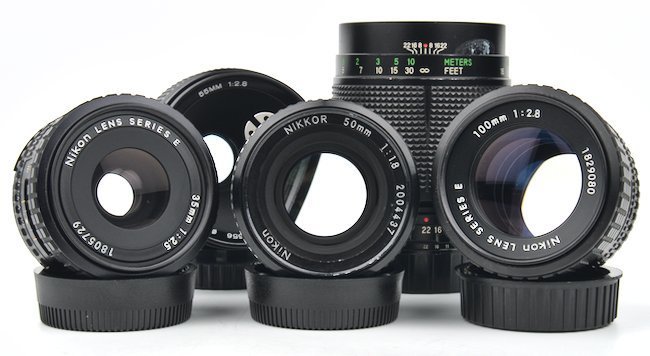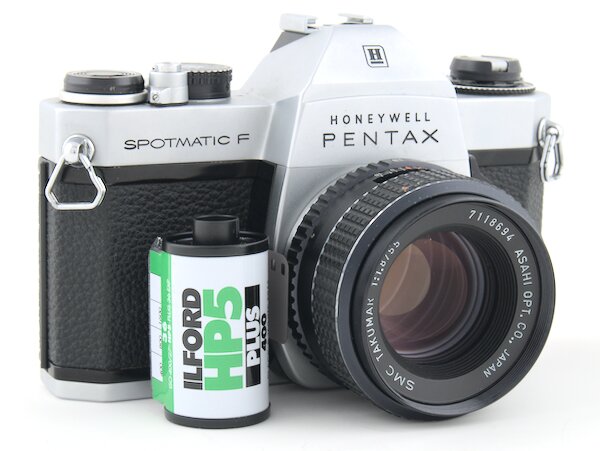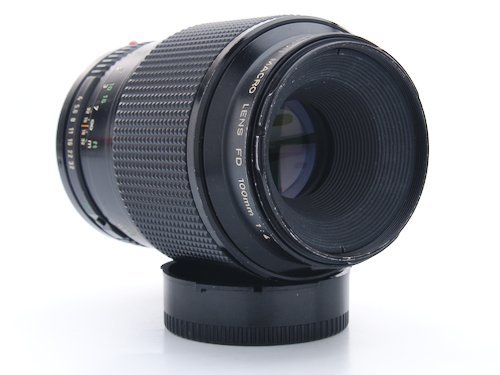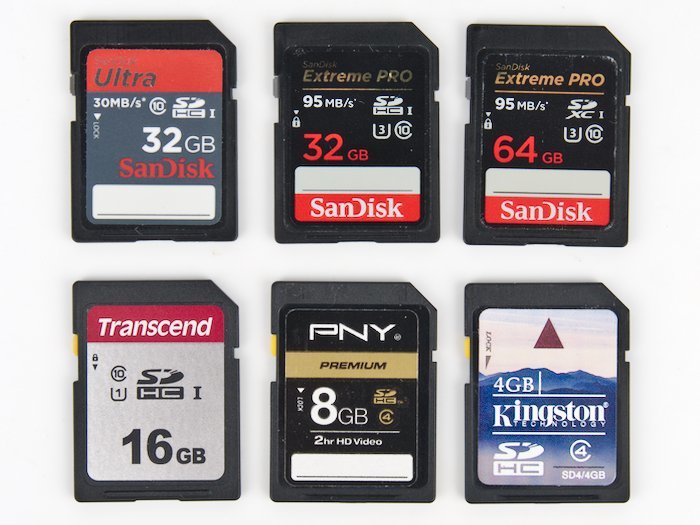
The 5 Best Nikon FG Lenses
- Nathaniel Stephan
- Nikon fg
- October 8, 2022
Table of Contents
The Nikon FG is a terrific film SLR camera. This web page will cover the 5 best lenses for the Nikon FG, plus a few alternative lenses.
Affiliate Advertising Disclosure
Outside the Shot is a participant in the Amazon Services LLC Associates Program, an affiliate advertising program designed to provide a means for sites to earn advertising fees by advertising and linking to Amazon.com.
As an eBay Partner, I may be compensated if you make a purchase. I also participate in affiliate advertising programs with KEH and Adorama. More can be found on the Affiliate Disclosure page.
Additional info is below, but if you are short on time, below is the list:
- Kit Lens - Nikon 50mm f/1.8 Series E
- Wide Angle Lens - Nikon Nikkor 24mm f/2.8 Ai
- Portrait Lens - Nikon 100mm f/2.8 Series E
- Zoom Lens - Vivitar Series 1 70-210mm f/3.5
- Macro Lens - Vivitar 90mm f/2.8
The best Nikon F-mount lenses are grouped by kind of photography and cost. There are a bunch of excellent lenses to select from that cover price ranges appropriate for the value of a FG.
Standard Prime Lens
A 50mm focal length lens is a very good choice for a vast array of photography. The types of photography consist of street, travel, portraits, everyday use, landscapes, and architecture. This is the most common focal length that is used on the Nikon FG.
Nikon 50mm f/1.8 Series E
https://www.outsidetheshot.com/nikon-f//nikon/nikon-50mm-f18-series-e.jpg does not exist- One of the most popular 50mm lenses Nikon ever made.
- Exceptional value.
- Light, small, and compact.
- 52mm filter threads.
See current price and more information on:
If you do not already own one, a great lens for the FG is the Nikon 50mm f/1.8 Series E. The 50mm f1.8 is simple to find, has good picture quality, is inexpensive, compact, and lightweight.
Make sure you get the second version of the lens, which has a chrome ring around the body of the lens. It is constructed from aluminum, whereas the first version has plastic parts.
The 50mm Series E lens is referred to as a pancake lens because of how thin it is. When mounted on the FG it barely sticks out. This is handy for carrying the camera under a jacket so you’re able to keep a low profile.
Nikon also released many other 50mm manual focus lenses for the F-mount.
Nikon Nikkor 50mm f/1.4
https://www.outsidetheshot.com/nikon-f//nikon/nikon-50mm-f14.jpg does not exist- Outstanding optics.
- Optical multi-coatings to reduce flare.
- Many copies are available.
- Relatively low-priced.
See current price and more information on:
The Nikon Nikkor 50mm f/1.4 is 2/3 of a stop faster, at the added cost of size and weight. It is slightly higher priced than any of the f/1.8 or f/2 lenses.
Voigtländer Nokton 58mm f/1.4 SL II AI-S
https://www.outsidetheshot.com/nikon-f//nikon/voigtlander-nokton-58mm-f14-sl.jpg does not exist- Fantastic optics.
- Has a Meter Coupling Prong.
- CPU Contacts.
- Available new.
See current price and more information on:
Nikon built a 50mm f/1.2 and 55mm f/1.2, but the value is poor. Due to the age of the lenses, you should be concerned about the lubricant in the focusing helicoid drying up, spoiling the experience of using the lens.
The Voightlander 58mm f/1.4 is overall a superior choice for a premium quality lens. It has the smoothest focusing ring| I’ve ever used on a manual focus lens. The Voigtländer is am absolute delight to use.
In addition, the lens keeps compatibility that spans all F-mount cameras. It has a CPU contacts, Ai Meter Coupling Ridge, Meter Coupling Prong, and has a switch to allow for electronic aperture control. You’re able to swap the lens from a Nikon film SLR to a Nikon DSLR seamlessly.
Alternative Standard Lenses
Below are several other good lenses that are comparable choices.
- Nikon Nikkor 50mm f/1.8
- Nikon Nikkor 50mm f/2
- Nikon 35mm f/2.5 Series E
- Nikon 28mm f/2.8 Series E
Wide Angle Lens
Nikon Nikkor 24mm f/2.8
https://www.outsidetheshot.com/nikon-f//nikon/nikon-24mm-f28.jpg does not exist- Great paired with a 50mm lens.
- Optical multi-coatings to reduce chromatic aberrations.
- Widely available.
- Comparatively inexpensive.
See current price and more information on:
The Nikon Nikkor 24mm f/2.8 is a very good selection for a wide-angle lens. The lens is ideal for architectural or landscape photography.
There are loads of wider focal lengths to choose from, but they are often are a great deal more expensive or have significant amounts of barrel distortion. Third-party lenses have clearly decreased image quality than Nikkor lenses.
Nikon 28mm f/2.8 Series E
https://www.outsidetheshot.com/nikon-f//nikon/nikon-28mm-f28-series-e.jpg does not exist- Good when used with a 50mm lens.
- Optical multi-coatings to improve performance.
- Widely available.
- Easily affordable.
See current price and more information on:
The Nikon 28mm f/2.8 Series E lens is a lower priced option. It is appealing to use on the FG thanks to the low price and ease at which the lens can be found.
Alternative Wide Angle Lenses
In terms of price, the correlation is easy to understand. The larger the field of view, the higher priced the lens will probably be. Lenses with larger apertures also sell for significantly more.
- Nikon 8mm f/2.8 Fisheye
- Nikon Nikkor 15mm f/3.5
- Nikon Nikkon 18mm f/3.5
- Nikon Nikkon 24mm f/2
- Nikon Nikkon 13mm f/5.6
- Nikon Nikkon 16mm f/2.8 Fisheye
- Nikon Nikkon 20mm f/2.8
Portrait & Telephoto Lens
Nikon 100mm f/2.8 Series E Lens
https://www.outsidetheshot.com/nikon-f//nikon/nikon-100mm-f28-series-e.jpg does not exist- 85mm alternative.
- Good value.
- Comparatively low-priced.
- Widely available.
See current price and more information on:
85mm lenses weren’t as prominently used as they are today compared to when the FG was originally produced in 1982. 135mm or 100mm focal lengths were more commonly used thanks to their less expensive price.
Just like all the other Series E lenses mentioned, the 100mm f/2.8 hits a fitting balance of price, capabilities, and functionality. That’s why it was very popular when released and why a lot of copies are available on the used market.
Nikon Nikkor 135mm f/2.8 Lens
https://www.outsidetheshot.com/nikon-f//nikon/nikon-135mm-f28.jpg does not exist- 85mm substitute.
- "Vintage" portraiture rendering.
- Easy to find.
See current price and more information on:
The “vintage” look of the Nikkor 135mm f/2.8 stems from the focal length combined with the lens only containing 4 elements.
1965 was the year the first version of the lens was produced. A total of 6 versions of the lens, with only the last two versions being suitable for the FG.
If you go to buy a copy of the lens, the compatible versions will be listed as Ai-S or Ai.
Alternative Telephoto Lenses
There is no shortage of alternative telephoto lenses to choose from. Focal lengths longer than 135mm and 85mm lenses will be pricey.
| Nikkor 85mm f/2 | Nikkor 105mm f/1.8 |
| Nikkor 105mm f/2.5 | Nikkor 135mm f/2 |
| Nikkor 135mm f/2.8 | Nikon 135mm f/2.8 Series E |
| Nikkor 180mm f/2.8 | Nikkor 200mm f/2 ED |
| Nikkor 300mm f/2 IF-ED | Nikkor 300mm f/2.8 |
| Nikkor 300mm f/4.5 | Nikkor 400mm f/2.8 IF-ED |
| Nikkor 500mm f/4 IF-ED P | Mirror Nikkor 500mm f/8 |
| Nikkor 600mm f/4 IF-ED | Nikkor 800mm f/5.6 IF-ED |
Nikon FG Zoom Lenses
Before cameras had autofocus, in the early 1980’s, there were a small number of lenses manufactured by third-party manufacturers that out-performed Nikkor lenses.
Some of these lenses would be released under the Vivitar brand name. Any lens that has the Vivitar Series 1 branding on it is going to have terrific optics.
Vivitar Series 1 70-210mm f/3.5
https://www.outsidetheshot.com/nikon-f//nikon/vivitar-70-210-f35.jpg does not exist- Covers a useful focal range.
- Excellent for portrait or wildlife photography.
- A rare example of when a third-party lens is the better choice.
See current price and more information on:
Alternative Zoom Lenses
Unfortunately, shorter focal length zoom lenses have issues making them a bad choice to use with the Nikon FG. Wear and tear along with age has resulted in many Nikon zoom lenses to become essentially unusable.
The only zoom I would advise looking for is the Vivitar Series 1 VMC 35-85mm f/2.8 (Also found on KEH). , the lens can be tough to find.
Vintage Zoom Lens Problems
The lens that ought to be the best choice, the Nikon Zoom-Nikkor 35-105mm f/3.5-4.5, is unfortunately, a push-pull zoom. In place of having a zoom ring, the focus ring is pushed or pulled to select the zoom range.
The grease in almost all push-pull zooms has broken down to the stage where the zoom mechanism is unable to support itself. Because of this, the lens will have tiny changes in focal length when attempting to focus the lens. This will be made worse if the lens is pointed up or down.
Nikon Macro Lenses
Komine made both of the two recommended macro lenses in Japan. The lenses were also released under many different brand names. Spiratone, Elicar, Rokunar, Panagor, and Quantaray are brands that also released the lenses.
There is a Vivitar 90mm f/2.8 Macro Lens Review and a Vivitar 55mm f/2.8 Macro Lens Review.
For capturing images at macro magnification (1x), the 90mm lens will be the superior choice due to the fact that it has a greater working distance.
For close-up and table-top photography, the 55mm macro lens is the better pick.
Vivitar 90mm f/2.8
https://www.outsidetheshot.com/nikon-f//nikon/vivitar-90mm-f28-macro-lens.jpg does not exist- My favorite vintage macro lens.
- Was produced in lots of different lens mounts.
- Great value.
See current price and more information on:
Vivitar 55mm f/2.8 Macro Lens
https://www.outsidetheshot.com/nikon-f//nikon/vivitar-55mm-f28-macro-lens.jpg does not exist- My second favorite vintage macro lens.
- A fantastic choice for close-up photography.
- Can achieve 1x magnification without the need for an extension tube.
See current price and more information on:
Alternative Macro Lenses
- Nikon Micro Nikkor 55mm f/3.5
- Lester A Dine 105mm f/2.8
- Micro Nikkor 105mm f/2.8
Used Nikon Camera Lens Prices
The prices of camera lenses change all the time based on supply and the popularity of vintage lenses. Over the past several years, film photography was seeing an increase in interest, which has pushed prices higher.
Economic conditions are ever-changing, and sudden changes can result in changes in prices. Having said that, the relative difference in prices between lenses should be expected to stay similar.
Checking several websites is the best way to get current lens pricing. If you are lucky enough to find a good deal, immediately buy it, because the best deals do not last long.
What Lens Mount Does the Nikon FG Use?
The Nikon FG uses the Nikon F lens mount. The Nikon F-mount has been in use since 1959. Changes have been made over time to add autofocus, CPU contacts, metering information, and electronically controlled apertures.
For the FG, you should use manual focus lenses that are either Ai-S or Ai. The meter coupling ridge on those lenses allows the camera to correctly meter light.
For an explanation F-mount lenses, this page explains everything you should know Nikon F-mount lens and camera compatibility.
Standard Lens Cap Size
The standard lens cap and filter ring thread size for the majority of vintage F-mount lenses is 52mm. It goes without saying, lenses with big front elements are going to require larger lens caps and filters.
The nice thing about having a standard filter thread size is that you only are required to have one set of filters.
Non Ai vs Ai & Ai-S Lenses
A Meter Coupling Prong was used on early Nikon cameras. The Nikon FG uses a Meter Coupling Ridge.
Lenses manufactured around the time when Nikon changed to Ai lenses may have both styles of meter coupling.
Older lenses that only have a Meter Coupling Prong will most likely damage your FG if you attempt to use one on the camera.


